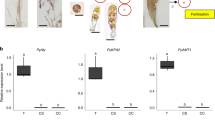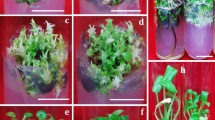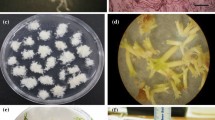Abstract
Two types of spore germination occur in the genus Bangia. The bipolar type is the most frequent, the resultant germlings developing into filaments which resemble the parent thallus. In addition, unipolar germination of certain spores to form filamentous growths with elongate cells has been reported1–6. Drew7 was able to identify similar filamentous growths obtained from spore germination in Porphyra as the alga previously described as Conchocelis rosea Batters. Later, Drew referred to Conchocelis, the product of germination of certain spores in Bangia, although she was not able to obtain the complete life history in culture3,4. Kurogi5 reported completion of the life history in culture for Bangia gloiopeltidicola, giving no details, while Ogata8 reported numerous uniseriate plants, presumably of Bangia fuscopurpurea, growing on calcite in which the Conchocelis-phase of that species had been grown, without being able to indicate their origin.
This is a preview of subscription content, access via your institution
Access options
Subscribe to this journal
Receive 51 print issues and online access
$199.00 per year
only $3.90 per issue
Buy this article
- Purchase on Springer Link
- Instant access to full article PDF
Prices may be subject to local taxes which are calculated during checkout
Similar content being viewed by others
References
Reinke, J., Jb. Wiss. Bot., 11, 274 (1878).
Kylin, H., K. Fysiogr. Sällsk. Lund. Förh., 16, 1 (1946).
Drew, K. M., Phytomorphology, 2, 38 (1952).
Drew, K. M., Pubbl. Staz. Zool. Napoli, 30, 358 (1958).
Kurogi, M., VIII Intern. Bot. Cong., Paris, 17, 74 (1954).
Belcher, J. H., New Phytol., 59, 367 (1960).
Drew, K. M., Nature, 164, 748 (1949).
Ogata, E., Bot. Mag. Tokyo, 68, 371 (1955).
Starr, R. C., Amer. J. Bot., 51, 1013 (1964).
Provasoli, L., McLaughlin, J. J. A., and Droop, M. R., Arch. Mikrobiol., 25, 392 (1957).
Hollenberg, G. J., Amer. J. Bot., 45, 653 (1958).
Drew, K. M., Ann. Bot., N. S., 18, 183 (1954).
Rentschler, H., Planta, 76, 65 (1967).
Dring, M. J., J. Mar. Biol. Assoc. UK, 47, 501 (1967).
Drew, K. M., Bot. Rev., 22, 554 (1956).
Conway, E., Brit. Phycol. Bull., 2, 362 (1964).
Dangeard, P., Botaniste, 18, 1 (1927).
Author information
Authors and Affiliations
Rights and permissions
About this article
Cite this article
RICHARDSON, N., DIXON, P. Life History of Bangia fuscopurpurea (Dillw.) Lyngb. in Culture. Nature 218, 496–497 (1968). https://doi.org/10.1038/218496a0
Received:
Revised:
Published:
Issue Date:
DOI: https://doi.org/10.1038/218496a0
This article is cited by
-
Temperature requirements for growth and survival of macroalgae from Disko Island (Greenland)
Helgoländer Meeresuntersuchungen (1993)
-
Photoperiodic and temperature responses in the growth and tetrasporogenesis ofGigartina acicularis (Rhodophyta) from Ireland
Helgoländer Meeresuntersuchungen (1984)
Comments
By submitting a comment you agree to abide by our Terms and Community Guidelines. If you find something abusive or that does not comply with our terms or guidelines please flag it as inappropriate.



